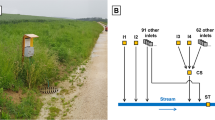Abstract
Regulators need a reliable, precise and easy to use tool for predicting the occurrence of pesticides in drain water and catchments in agricultural areas. Occurrence depends on a wide range of substance and site specific factors and this study presents a simple model built on the results from simulations of a detailed model system that does not neglect or omit any of these factors. A drainage dominated sub-catchment (0.03 km2) of the Lillebaek catchment (4.4 km2) on Funen, Denmark, represented by the catchment model MIKE SHE is considered. Detailed analyses have been made with respect to geological and hydrodynamic conditions as well as measurements of pesticide concentrations in ground and surface waters. Maximum concentrations in drain water, the time for reaching this concentration and the time interval for exceeding the limit value have been derived empirically from MIKE SHE simulations using degradation rates and sorption coefficients values for 37 pesticides included in the Danish PATE database. The relatively hydrophilic bentazon and hydrophobic pendimethalin are used as model pesticides for illustration. A simple tool applicable for a wide range of pesticides has thus been designed based on detailed analyses of a limited number of pesticides. The user requirements are degradation rates, sorption coefficients, application rates and regulatory limit values for the pesticides of interest.






Similar content being viewed by others
References
Abbott, M. B., Bathurst, J. C., Cunge, J. A., O’Connell, P. E., & Rasmussen, J. (1986). An introduction to the European hydrological system – system hydrologique Européen “SHE” 2: Structure of a physically based distributed modelling system. Journal of Hydrology, (87), 61–77.
Boesten, J., Helweg, A., Businelli, M., Bergstrom, L., Schaefer, H., Delmas, A., et al. (1997). Soil Persistence Models and EU Registration. The final report of the work of the Soil Modelling Work group of FOCUS (FOrum for the Co-ordination of pesticide fate models and their Use).
Boesten, J., & van der Linden, T. (1991). Modeling the influence of sorption and transformation on pesticide leaching and persistence. Journal of Environmental Quality, (20), 425–435.
Christiansen, J. S., Thorsen, M., Clausen, T., Hansen, S., & Refsgaard, J. C. (2002). Modelling of macropore flow and transport processes at catchment scale. Journal of Hydrology, 299(1–2), 136–158.
DHI (Danish Hydraulic Institute) (2000). MIKE SHE Water movement user manual. DHI Water & Environment, Hørsholm, Denmark http://www.dhigroup.com/).
EPA (2007). PRZM http://www.epa.gov/ceampubl/gwater/przm3/prz3reln.htm).
FOCUS (2000). FOCUS Groundwater scenarios in the EU review of active substances. Report of the FOCUS Groundwater Scenarios Workgroup, EC Document Reference Sanco/321/2000 rev.2, 2002 pp.
Hertwich, E. G., McKone, T. E., & Pease, W. S. (1999). Parameter uncertainty and variability in evaluative fate and exposure models. Risk Analysis, 19(6).
Jager, T., Rikken, M. G. J., & van der Poel, P. (1999). Uncertainty analysis of EUSES: Improving risk management by probabilistic risk assessment. National Institute of Public Health and the Environment (RIVM), Report 679102039, Bilthoven, The Netherlands.
Jarvis, N. (1991). MACRO – a model of water and solute transport in macroporous soils. Reports and dissertations no. 9, Department of Soil Sciences, Swedish University of Agricultural Sciences, Uppsala, Sweden, pp 58.
Jury, W. A., & Sposito, G. (1985). Field calibration and validation of solute transport models for the unsaturated zone. Soil Science Society of America Journal, (49), 1331–1341.
PATE (2001). Pesticides and the environment database. Danish Environmental Protection Agency.
Refsgaard, J. C., & Storm, B. (1995). MIKE SHE. In V. P. Singh (Ed.), Computer models of watershed hydrology (pp. 809–846). Water Resources Publication.
Sørensen, P. B., Carlsen, L., Fauser, P., & Vikelsøe, J. (2001). Paradigm for analysing complex model uncertainty. A general concept for dealing with uncertainties in ecotoxicological models, Research Notes from NERI (Denmark), No. 141. http://www2.dmu.dk/1_viden/2_Publikationer/3_arbrapporter/rapporter/AR141.pdf).
Styczen, M., Petersen, S., Christensen, M., Jessen, O. Z., Rasmussen, D., Andersen, M. B., et al. (2002). Calibration of models describing pesticide fate and transport in Lillebaek and Odder Baek Catchment. Ministry of the Environment, Danish Environmental Protection Agency, Pesticides Research No. 62.
van Asselt, M. B. A. (2000). Perspectives on uncertainty and risk. Dordrecht, The Netherlands: Kluwer Academic Publishers.
Walcher, S., Altschuh, J., Schramm, K.-W., & Mayer, S. (2003). Estimates in deterministic fate modelling of environmental chemicals. Environmental Modelling & Software, (18), 929–936.
Wolters, A., Klein, M., & Vereecken, H. (2004). An improved description of pesticide volatilization: Refinement of the Pesticide Leaching Model (PELMO). Journal of Environmental Quality, (33), 1629–1637.
Author information
Authors and Affiliations
Corresponding author
Rights and permissions
About this article
Cite this article
Fauser, P., Thomsen, M., Sørensen, P.B. et al. Predicted Concentrations for Pesticides in Drainage Dominated Catchments. Water Air Soil Pollut 187, 149–156 (2008). https://doi.org/10.1007/s11270-007-9503-0
Received:
Accepted:
Published:
Issue Date:
DOI: https://doi.org/10.1007/s11270-007-9503-0




